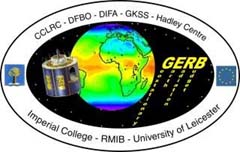Dataset Collection
Geostationary Earth Radiation Budget (GERB): Solar and thermal radiation Data
Abstract
The Geostationary Earth Radiation Budget (GERB) instrument makes accurate measurements of the Earth Radiation Budget. It was specifically designed to be mounted on a geostationary satellite and was carried onboard the Meteosat Second Generation satellite operated by European Organisation for the Exploitation of Meteorological Satellites (EUMETSAT). The first GERB instrument, GERB-2, was onboard Meteosat Second Generation satellite, MSG-1, and began transmitting data on 12th December 2002. GERB-1 was launched onboard MSG-2 on 21st December 2005. Future GERB sensors units are planned for MSG-3 and MSG-4.
This dataset collection contains the incident and reflected solar radiation together with thermal radiation emitted by the Earth's atmosphere. The amount of solar radiation absorbed is the difference between the the incoming and reflected solar radiation and is the energy source of the Earth-atmosphere system. The thermal radiation emitted by the atmosphere is the only sink of energy so, therefore, the budget is the difference between the two. Seasonal changes in the ERB are mainly due to changes in incoming solar radiation but there is a large amount of variability on timescales of hours to days, mainly due to clouds. The global coverage and sampling frequency required for accurate climate models requires that ERB measurements are made from satellites.
Details
| Previous Info: | No news update for this record |
|---|---|
| Previously used record identifiers: |
http://badc.nerc.ac.uk/view/badc.nerc.ac.uk__ATOM__dataent_gerb
|
Related Documents
Temporal Range
2004-03-28T00:00:00
2013-01-31T23:59:59
Geographic Extent
60.0000° |
||
-60.0000° |
60.0000° |
|
-60.0000° |

